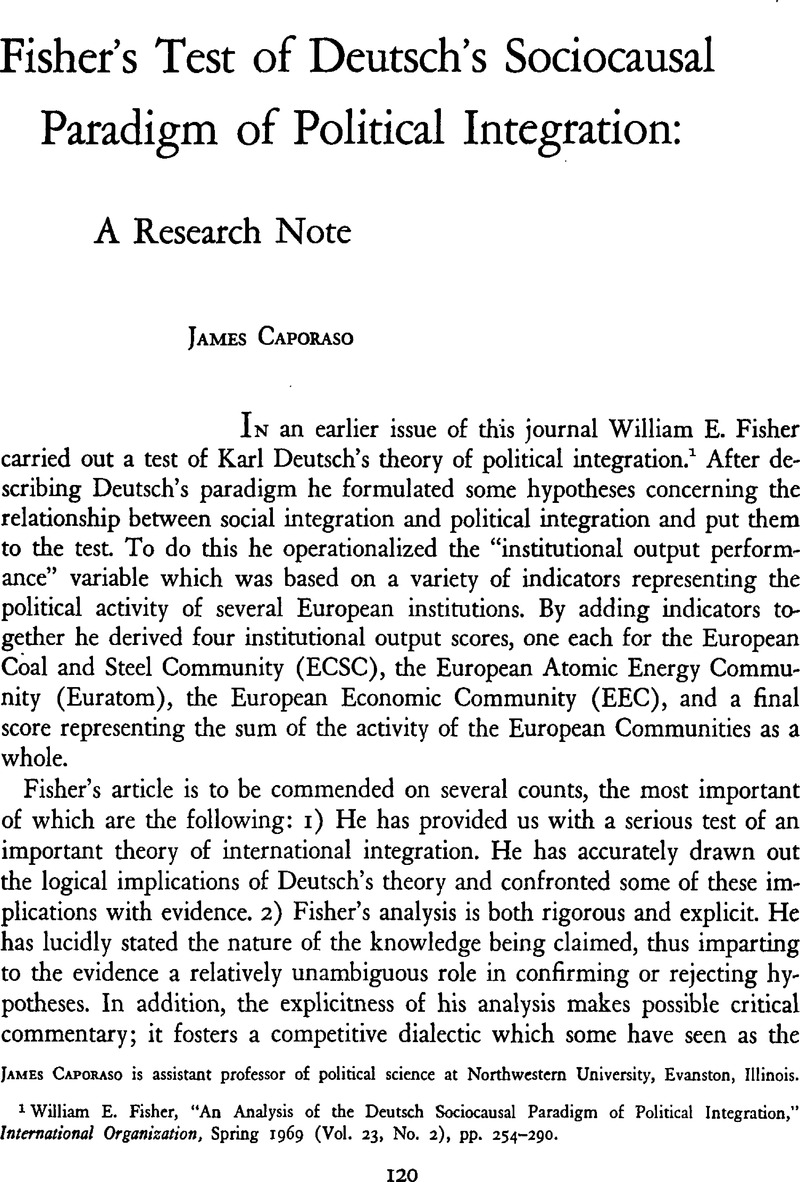Article contents
Fisher's Test of Deutsch's Sociocausal Paradigm of Political Integration: A Research Note
Published online by Cambridge University Press: 22 May 2009
Abstract

- Type
- Notes on Theory and Method
- Information
- Copyright
- Copyright © The IO Foundation 1971
References
1 Fisher, William E., “An Analysis of the Deutsch Sociocausal Paradigm of Political Integration,” International Organization, Spring 1969 (Vol. 23, No. 2), pp. 254–290CrossRefGoogle Scholar.
2 For this interpretation of the growth of knowledge see Popper, Karl R., Conjectures and Refutations: The Growth of Scientific Knowledge (New York: Basic Books Publishers, 1962)Google Scholar; Polanyi, Michael, “The Growth of Science in Society,” Minerva, Summer 1967 (Vol. 5, No. 4), pp. 533–545CrossRefGoogle Scholar; Feyerabend, P. K., “How to Be a Good Empiricist—A Plea for Tolerance In Matters Epistemological,” in Nidditch, P. H., ed., The Philosophy of Science (Oxford Readings in Philosophy) (London: Oxford University Press, 1968), pp. 12–39Google Scholar; and Campbell, D. T., “Evolutionary Epistemology,” Northwestern University, 1969. (Mimeographed.)Google Scholar.
3 Fisher, , International Organization, Vol. 23, No. 2, p. 262Google Scholar.
4 Ibid. Technically, Fisher is proposing what measurement theorists call an “additive response model” in which each indicator is treated as a manifestation of the attribute in question much in the way each item (question) on a test is treated as a manifestation of intelligence. This model derives part of its rationale from the distinction between “true” and “error” components of measures. Thus, we use the familiar formula:
x = t + e
in which x equals the obtained score, t the “true” score, and e the error component. The “true” score is unknown, of course, but it is estimated from the common variance shared by several indicators. It is assumed that the true score will be invariant from indicator to indicator while the error terms will be uncorrelated. In the absence of any evidence concerning correlations between indicators these components cannot even be estimated.
5 See, for example, Nunnally, Jum C., Psychometric Theory (New York: McGraw-Hill Book Co., 1967)Google Scholar, especially chapters 6, 7, and 8; Peak, Helen, “Problems of Objective Observation,” in Festinger, Leon and Katz, Daniel, eds., Research Methods in the Behavioral Sciences (New York: Holt, Rinehart & Winston, 1965), pp. 243–299Google Scholar; and Scott, William A., “Attitude Measurement,” in Lindzey, Gardner and Aronson, Elliot, eds., The Handbook of Social Psychology, Vol. 2: Research Methods (2nd ed.; Reading, Mass: Addison-Wesley Publishing Co., 1968), p. 211Google Scholar.
6 Scott, in Lindzey and Aronson, p. 219.
7 Zetterberg, Hans, On Theory and Verification in Sociology (3rd enlarged ed.; Totowa, N.J: Bedminster Press, 1965), pp. 123–126Google Scholar.
8 Ibid., p. 123.
9 Kerlinger, Fred N., Foundations of Behavioral Research: Educational and Psychological Inquiry (New York: Holt, Rinehart & Winston, 1964), p. 443Google Scholar.
10 Galtung, Johan, Theory and Methods of Social Research (New York: Columbia University Press, 1967). P 300Google Scholar.
11 Some authors take the position that trend or autocorrelation is artifactual and should be eliminated from different data distributions before correlating them. The argument goes on to state that if two variables (indicators) have strong positive trend components (i.e., they are both rapidly increasing), they will show high correlations irrespective of how observations distribute around the trend lines. With respect to Fisher's theory of political integration, as well as my own, it appears that the trend (growth) component is what is theoretically significant. What constitutes artifact is clearly a situational matter.
12 Scott, in Lindzey and Aronson, p. 255.
13 This procedure, usually called Z-scoring, is outlined by Blalock, Hubert M., Social Statistics (Series in Sociology) (New York: McGraw-Hill Book Co., 1960), pp. 81–83Google Scholar; Barrera, Mario and Haas, Ernst B. suggest a variant of this, T-scores, in “The Operationalization of Some Variables Related to Regional Integration: A Research Note,” in International Organization, winter 1969 (Vol. 23, No. 1), pp. 150–160CrossRefGoogle Scholar.
14 Barrera, and Haas, , International Organization, Vol. 23, No. 1, p. 157Google Scholar.
15 It should be noted that the argument here is not against weighting some indicators more than others. This is a separate argument and one that must be decided according to explicit theoretical criteria. The point here is that weighting should be performed on standardized measures—not on raw data. Fisher's data is thus weighted twice: once by design, once by accident.
16 Campbell, Donald T., “Definitional versus Multiple Operationism,” Et Al., Summer 1969 (Vol. 2, No. 1), p. 16Google Scholar.
17 For a discussion of factor analysis and cluster analysis see Fruchter, Benjamin, Introduction to Factor Analysis (Textbooks on Psychology) (New York: D. Van Nostrand Co., 1954)Google Scholar.
18 Noël, Emile, “How the European Economic Community's Institutions Work,” in European Community Information Service, Community Topics, 12 1966 (No. 27), pp. 4–6Google Scholar.
19 Fisher, , International Organization, Vol. 23, No. 2, p. 286Google Scholar.
20 Galtung, p. 301.
21 Osgood, Charles E., Suci, George J., and Tannenbaum, Percy H., The Measurement of Meaning (Urbana: University of Illinois Press, 1967), p. 11Google Scholar.
22 Feycrabend, in Nidditch, p. 15.
23 The relative acceptance index is a measure of the extent to which transactions between any set of countries deviates from what one would “expect” on the basis of chance (i.e., assuming independence of origin and destination of imports and exports). As such it is indifferent to changes in patterns of behavior between two nations if such changes are part of a general change characterizing the behavior of these nations with the rest of the world.
24 Similarly, Thomas Kuhn reminds us that there is no such thing as a “pure observation language” which is neutral with respect to the theory being tested. See Kuhn, Thomas S., The Structure of Scientific Revolutions (Chicago: University of Chicago Press, 1962), p. 145Google Scholar.
25 Bacon, Francis, Novum Organum, Vol. 8 of The Works of Francis Bacon, ed. Spedding, J., Ellis, R. L., and Heath, D. D. (14 vols.; New York: Garrett Press, 1969), p. 210Google Scholar.
- 3
- Cited by




